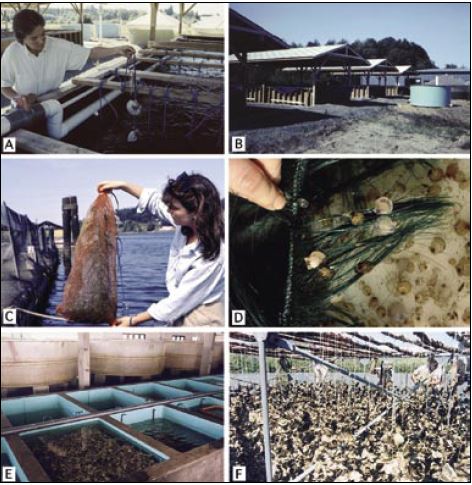6.3.2 Growing systems for spat set on cultch
Tanks systems – essentially similar to those described for remote setting in the previous section – are commonly used in the hatchery for the initial stages of the growth of oyster, scallop and mussel spat set on cultch (Figure 91). They may be closed systems, i.e. with a static volume of water changed two or three times each week, or open systems operated on flow-through, depending on the extent to which the water needs heating.
Very often they will be a combination of the two with aeration to mix and circulate the water and the daily food ration throughout the tank volume. Food will be added continuously in the case of flow-through. Oyster spat may spend as little as a week in these systems whereas the slower growing scallops and mussels will stay longer before transfer to the sea.
Sand-filtered water or water filtered to about 20 ?m particle size is usually used at this stage so that spat can benefit from the diversity of naturally occurring algal species in the water in addition to the added ration of cultured food. Feeding is not usually closely controlled in terms of species composition of the diet and ration. Enough food will be added to the tanks to colour the water sufficiently. If the algae is grazed quickly then more will be added.
If the water is heated then spat will be gradually acclimated to ambient sea temperature before leaving the hatchery.

Figure 91: Simple tank systems are used for growing spat set on cultch. They are either closed or flow-through systems or a combination of both. A – growing tanks mainly used for scallop spat set on cultch at a British Columbia hatchery. B – note that the lined plywood tanks are situated outdoors and are roofed over to shade the water surface. C – scallop spat may be set on filamentous cultch packed in onion bags, initially in tanks of the type shown in A and B at the hatchery site. D – detail of spat set on the filamentous material after a period of floating culture in the sea. E – growing mangrove oyster spat set on strings of oyster shell cultch at a Cuban hatchery. F – when the spat are 2 or 3 mm in size the strings of cultch are hung from mangrove poles on rafts located in productive waters.